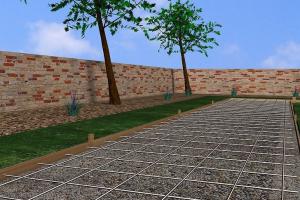Mastering Curved Concrete Sidewalks: A Comprehensive Guide to Building Forms

-
Quick Links:
- 1. Introduction
- 2. Understanding Concrete
- 3. Tools and Materials Needed
- 4. Site Preparation
- 5. Designing the Form
- 6. Building the Form
- 7. Pouring the Concrete
- 8. Finishing Techniques
- 9. Case Studies
- 10. Expert Insights
- 11. FAQs
1. Introduction
Building forms for a curving concrete sidewalk is an essential skill for any DIY enthusiast or professional landscaper. Whether you're enhancing your home's curb appeal or creating a functional path through your garden, understanding how to construct these forms accurately is crucial. This guide will walk you through each step of the process, ensuring you have the knowledge and confidence to tackle this project successfully.
2. Understanding Concrete
Concrete is a versatile material that can be molded into various shapes and sizes, making it perfect for sidewalks. Understanding its properties is essential to ensure your sidewalk is durable and aesthetically pleasing.
- Composition: Concrete is made of cement, water, sand, and aggregate.
- Curing: Proper curing is crucial for strength and durability.
- Mix Ratios: Different mixes can yield different results; consult an expert for specific needs.
3. Tools and Materials Needed
Before starting, gather all necessary tools and materials to ensure a smooth process:
- Wooden boards or metal forms
- Measuring tape
- Level
- Hammer and nails or screws
- Concrete mix
- Shovel and trowel
- Safety gear (gloves, goggles)
4. Site Preparation
Preparing the site is critical for the success of your sidewalk. Follow these steps:
- Choose the location and mark the path of the sidewalk.
- Excavate the area to a depth of about 4-6 inches.
- Ensure the ground is compacted and level.
5. Designing the Form
The design of your form will dictate the final shape of your sidewalk. Consider the following:
- Determine the curve: Use garden hoses or ropes to visualize the curve.
- Decide on the width: A standard width is 4 feet; adjust according to your needs.
- Plan for drainage: Ensure the sidewalk slopes slightly away from any structures.
6. Building the Form
Once your design is complete, it’s time to build the form. Follow these steps:
- Cut the wooden boards to your desired lengths.
- Align the boards according to your design, securing them with nails or screws.
- Check for level and adjust as necessary.
7. Pouring the Concrete
Now that your form is ready, it’s time to pour the concrete:
- Mix the concrete according to the manufacturer's instructions.
- Pour the concrete into the form, starting at one end.
- Use a trowel to spread and level the concrete.
8. Finishing Techniques
Finishing your sidewalk is essential for both aesthetics and safety:
- Texturing: Use a broom or stamp to add texture.
- Sealing: Apply a concrete sealant once cured to protect against weathering.
9. Case Studies
Here are two real-world examples demonstrating successful curving sidewalk projects:
Case Study 1: Residential Garden Path
A homeowner in Springfield needed a pathway leading from their patio to a garden. Using a combination of wooden forms and a light-colored concrete mix, they achieved a beautiful and functional design that complemented their landscaping.
Case Study 2: Public Park Sidewalk
A city park in Riverside underwent renovations where curving sidewalks improved accessibility. The project utilized metal forms for precision and durability, ensuring a long-lasting addition to the park.
10. Expert Insights
We reached out to industry experts for their tips on building forms for curving concrete sidewalks:
"Investing time in the design phase pays off significantly. The more accurately you plan, the smoother the build will go." - John, Landscape Architect
"Don’t rush the curing process. It's essential for the longevity of your sidewalk." - Sarah, Concrete Specialist
11. FAQs
- 1. How long should I wait before using the sidewalk?
- Typically, you should wait at least 24-48 hours before walking on your newly poured sidewalk.
- 2. Can I use plastic forms instead of wood?
- Yes, plastic forms are lightweight and flexible, making them a good option for curving sidewalks.
- 3. What is the ideal weather for pouring concrete?
- The best weather is dry and mild, ideally between 50°F and 85°F.
- 4. How do I fix cracks in my sidewalk?
- Small cracks can be repaired with a concrete patch, while larger issues may require professional assessment.
- 5. Is it necessary to seal my concrete sidewalk?
- Sealing helps protect against moisture and stains, extending the life of your sidewalk.
- 6. Can I add color to my concrete sidewalk?
- Yes, you can use concrete dyes or stains to add color before the concrete sets.
- 7. How do I ensure proper drainage for my sidewalk?
- Ensure the sidewalk slopes away from buildings and other structures to prevent water pooling.
- 8. What thickness should my concrete sidewalk be?
- A thickness of 4 inches is standard for sidewalks.
- 9. How can I make my sidewalk slip-resistant?
- Adding texture or using slip-resistant additives in the concrete mix can enhance safety.
- 10. How do I maintain my concrete sidewalk?
- Regular cleaning and resealing every few years can help maintain its appearance and durability.
Random Reads